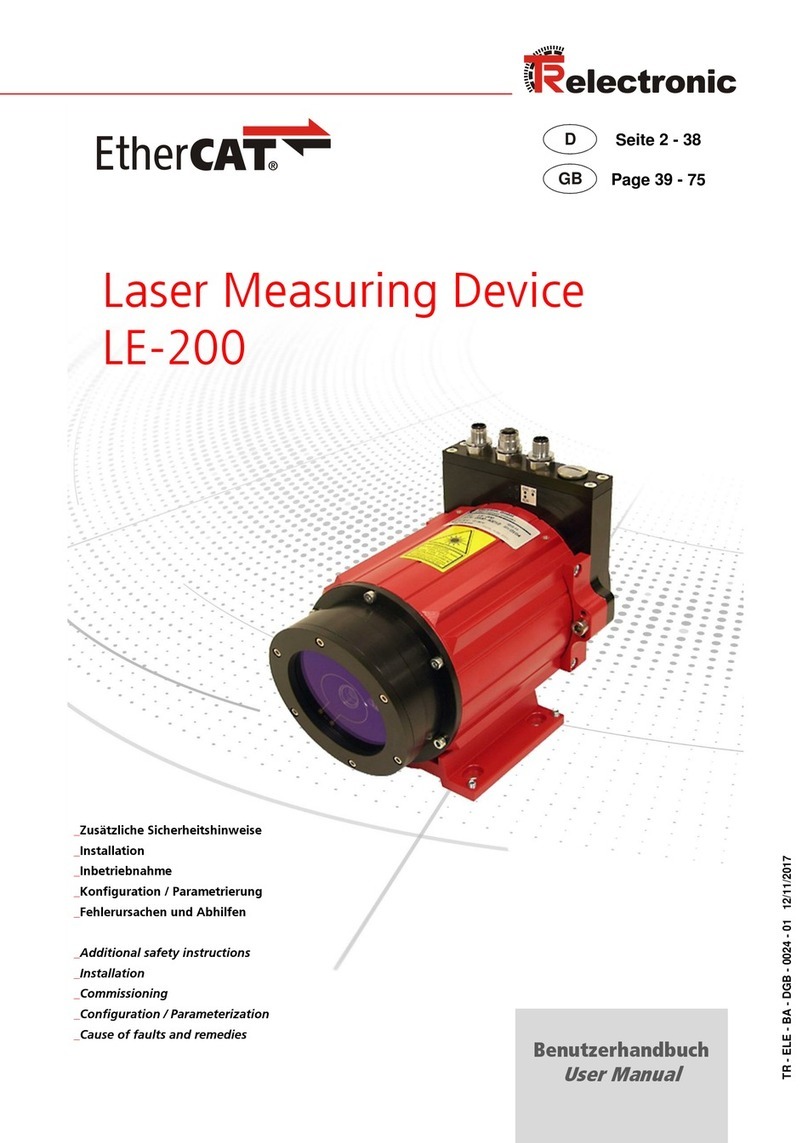
TR-Electronic GmbH 2007, All Rights Reserved Printed in the Federal Republic of Germany
Page 4 of 47 TR - ELE - BA - GB - 0010 - 10 12/08/2017
6 Communication profile ................................................................................................................... 26
6.1 Transmitting of the position value........................................................................................... 26
6.1.1 1st Transmit Process Data Object (asynchronous)................................................. 27
6.1.2 2nd Transmit Process Data Object (synchronous) .................................................. 27
6.2 Read/Write Service Data Object............................................................................................. 28
6.2.1 Read SDO:.............................................................................................................. 28
6.2.2 Write SDO:.............................................................................................................. 29
7 Communication specific standard objects................................................................................... 30
7.1 Object 1000h: Device Type .................................................................................................... 31
7.2 Object 1001h: Error Register.................................................................................................. 31
7.3 Object 1002h: Manufacturer Status Register ......................................................................... 31
7.4 Object 1003h: Pre-defined Error Field.................................................................................... 32
7.5 Object 1004h: Number of PDOs supported............................................................................ 33
7.6 Object 1005h: COB-ID SYNC message................................................................................. 33
7.7 Object 1008h: Manufacturer Device Name ............................................................................ 34
7.8 Object 1009h: Manufacturer Hardware Version..................................................................... 34
7.9 Object 100Ah: Manufacturer Software Version ...................................................................... 34
7.10 Object 100Bh: Node-ID......................................................................................................... 34
7.11 Object 100Ch: Guard-Time................................................................................................... 34
7.12 Object 100Dh: Life Time Factor............................................................................................ 35
7.13 Object 100Eh: Node Guarding Identifier............................................................................... 35
7.14 Object 1010h: Store Parameters.......................................................................................... 35
8 Parameterization and configuration.............................................................................................. 37
8.1 Standardized encoder profile area ......................................................................................... 37
8.1.1 Object 2000 –Clear Preset..................................................................................... 38
8.1.2 Object 2001 –Output value in case of an error...................................................... 38
8.1.3 Object 2003 –Function external input.................................................................... 39
8.1.4 Object 2004 –Automatic error acknowledgement.................................................... 39
8.1.5 Object 2005 –Function error output....................................................................... 39
8.1.6 Object 2006 –Switching functions.......................................................................... 40
8.1.7 Object 2007 –Resolution........................................................................................ 40
8.1.8 Object 6000h –Operating parameters ................................................................... 41
8.1.9 Object 6003h –Preset value .................................................................................. 41
8.1.10 Object 6004h –Position value.............................................................................. 42
8.1.11 Object 6005h –Measuring step............................................................................ 42
8.1.12 Object 6200h –Cyclic timer.................................................................................. 42
8.2 Laser diagnostics.................................................................................................................... 43
8.2.1 Object 6500h - Operating status............................................................................. 43
8.2.2 Object 6501h –Measuring step.............................................................................. 43
8.2.3 Object 6503h - Alarms............................................................................................ 43
8.2.4 Object 6504h - Supported alarms........................................................................... 44
8.2.5 Object 6505h - Warnings........................................................................................ 44
8.2.6 Object 6506h - Supported warnings ....................................................................... 45









































